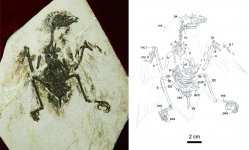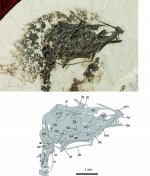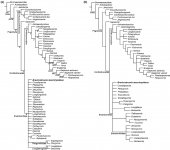Fred Ruhe
Well-known member

Zhiheng Li, Min Wang, Thonmas A. Stidham, Zhonghe Zhou & Julia Clarke, in press
Novel evolution of a hyper-elongated tongue in a Cretaceous enantiornithine from China and the evolution of the hyolingual apparatus and feeding in birds
Journal of Anatomy. in press.
doi:10.1111/joa.13588
Abstract: https://onlinelibrary.wiley.com/doi/10.1111/joa.13588
The globally distributed extinct clade Enantiornithes comprises the most diverse early radiation of birds in the Mesozoic with species exhibiting a wide range of body sizes, morphologies, and ecologies. The fossil of a new enantiornithine bird, Brevirostruavis macrohyoideus gen. et sp. nov., from the Lower Cretaceous Jiufotang Formation in Liaoning Province, northeastern China, preserves a few important skeletal features previously unknown among early stem and extant birds, including an extremely elongate bony hyoid element (only slightly shorter than the skull), combined with a short cranial rostrum. The long hyoid provides direct evidence for the evolution of specialized feeding in this extinct species, and appears similar to the highly mobile tongue that is mobilized by the paired epibranchials present in living hummingbirds, honeyeaters, and woodpeckers. The likely linkage between food acquisition and tongue protrusion might have been a key factor in the independent evolution of particularly elongate hyobranchials in early birds.
Enjoy,
Fred
Novel evolution of a hyper-elongated tongue in a Cretaceous enantiornithine from China and the evolution of the hyolingual apparatus and feeding in birds
Journal of Anatomy. in press.
doi:10.1111/joa.13588
Abstract: https://onlinelibrary.wiley.com/doi/10.1111/joa.13588
The globally distributed extinct clade Enantiornithes comprises the most diverse early radiation of birds in the Mesozoic with species exhibiting a wide range of body sizes, morphologies, and ecologies. The fossil of a new enantiornithine bird, Brevirostruavis macrohyoideus gen. et sp. nov., from the Lower Cretaceous Jiufotang Formation in Liaoning Province, northeastern China, preserves a few important skeletal features previously unknown among early stem and extant birds, including an extremely elongate bony hyoid element (only slightly shorter than the skull), combined with a short cranial rostrum. The long hyoid provides direct evidence for the evolution of specialized feeding in this extinct species, and appears similar to the highly mobile tongue that is mobilized by the paired epibranchials present in living hummingbirds, honeyeaters, and woodpeckers. The likely linkage between food acquisition and tongue protrusion might have been a key factor in the independent evolution of particularly elongate hyobranchials in early birds.
Enjoy,
Fred






